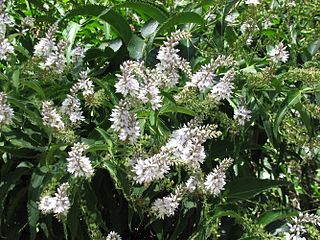
Veronica chamaedrys, the germander speedwell, bird's-eye speedwell, or cat's eyes, is a herbaceous perennial species of flowering plant in the plantain family Plantaginaceae.

Veronica officinalis, the heath speedwell, common gypsyweed, common speedwell, or Paul's betony, is a species of flowering plant in the plantain family Plantaginaceae. It is native to Europe and western Asia. It has been introduced to North America and is widely naturalised there.

Veronica is the largest genus in the flowering plant family Plantaginaceae, with about 500 species. It was formerly classified in the family Scrophulariaceae. Common names include speedwell, bird's eye, and gypsyweed.

Veronica persica is a flowering plant in the family Plantaginaceae. Common names include birdeye speedwell, common field-speedwell, Persian speedwell, large field speedwell, bird's-eye, or winter speedwell. It is native to Eurasia and is widespread as an introduced species in the British Isles, North America, eastern Asia, including Japan and China, and Australia and New Zealand.

Veronica agrestis, the green field-speedwell is a species of flowering plant in the Plantaginaceae (Plantain) family. It is native to Europe, western Asia and North Africa, and has been introduced to eastern North America, India and some other countries.

Veronica polita, the grey field-speedwell is a species of flowering plant in the Plantaginaceae (Plantain) family. It is native to Europe, south western Asia, North Africa, the Arabian Penninsula and a few nearby countries, and has been introduced to many countries worldwide particularly as a weed of cultivation.

Veronica serpyllifolia, the thyme-leaved speedwell or thymeleaf speedwell, is a perennial flowering plant in the plantain family. The species as a whole is native mostly to Eurasia & North America, and has three variants with their individual ranges; var. serpyllifolia has particularly spread beyond its native range.

Luzula sylvatica, commonly known as greater wood-rush or great wood-rush, is a perennial flowering plant in the rush family Juncaceae.

Veronica derwentiana, commonly known as Derwent speedwell, is a flowering plant species of the family Plantaginaceae, endemic to south-eastern Australia. It is a perennial with toothed leaves and white or pale blue flowers in terminal sprays in spring and summer.

Veronica anagallis-aquatica is a species of flowering plant in the family Plantaginaceae known by the common names water speedwell, blue water-speedwell,brook pimpernel.

Veronica filiformis is a species of flowering plant in the family Plantaginaceae. It is known by many common names, including slender speedwell, creeping speedwell, threadstalk speedwell and Whetzel weed. It is native to eastern Europe and western Asia, and it is known in many other regions as an introduced species.

Veronica scutellata is a species of flowering plant in the plantain family known by the common names marsh speedwell, skullcap speedwell, and grassleaf speedwell. It is native to temperate Asia, Europe, northern Africa, and northern North America in a variety of wet habitats.

Veronica gentianoides, the gentian speedwell, is a species of flowering perennial plant in the family Plantaginaceae found in the Middle East, from Turkey to Iran.

Veronica plebeia, commonly known as creeping- or trailing speedwell, is a species of flowering plant belonging to the family Plantaginaceae. It is native to Australia and New Zealand.

Veronica calycina, commonly known as hairy speedwell or cup speedwell, is a flowering plant in the family Plantaginaceae. It is a trailing perennial with dark green leaves, purple-blue flowers and is endemic to Australia.

Veronica gracilis is a plant belonging to the family Plantaginaceae, commonly known as slender speedwell. It is a perennial herb with slender branches, variable shaped leaves and small lilac flowers in spring and summer.

Veronica verna is a species of flowering plant in the Plantaginaceae (Plantain) family known as spring speedwell. It is native to Europe, south-western Asia and Morocco, but introduced to some parts of the United States.

Veronica catenata, the pink water speedwell, is a species of flowering plant in the family Plantaginaceae. It is native to Canada, the United States, Europe, the Azores, and northern Africa. As its common name implies, it prefers growing in or near marshes, rivers, lakes and ponds.

Veronica ciliolata, commonly known as the fringed speedwell or small speedwell, is a species of flowering plant native to New Zealand. It belongs to the family Plantaginaceae and is known for its delicate fringed petals and compact growth habit.
Veronica grisebachii is a small flower in the family Plantaginaceae native from Bulgaria to Turkey.



















